iPad Air (2020) review
Apple’s branding conventions can be confusing at times. A product designated ‘Air’ used to mean one that was super-portable but compromised on power; but while the 2020 iPad Air is indeed slim and light, it’s far more powerful than the standard iPad.
In fact, in many ways the latest Air has more in common with the top-of-the-range iPad Pro, boasting a state-of-the-art processor and modern design that you won’t find on the iPad 10.2in and iPad mini (for the time being, at least). Portability is one of this device’s trump cards, but it has far more to offer.
In our iPad Air (2020) review we run the device through our rigorous speed, graphics and battery benchmarks, thoroughly test its cameras, and evaluate it for build quality and ease of use. We’ll help you decide if this is the tablet for you.
For broader advice, read our iPad buying guide, and remember to check our roundup of the best iPad deals.
Design & build quality: A modern look
At first glance you’d be forgiven for thinking someone made an error and handed you an iPad Pro by mistake. This is essentially the Pro design, allowed for the first time to diffuse into the rest of the range: squared-off edges, all screen (or close to it; the iPad Pro 11in actually has slightly narrower bezels) with curved corners, no Home button, and a USB-C port at the bottom instead of Lightning.
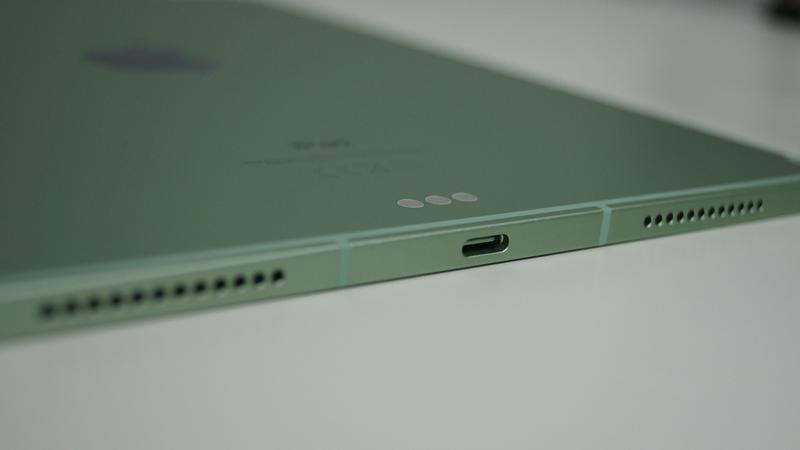

It’s delightfully slim and light, and again far closer to the Pro than the plain iPad: 6.1mm thick, to the iPad’s 7.5mm and the iPad Pro’s 5.9mm. And at 458g/460g (Wi-Fi/cellular) it’s lighter even than the Pro – although that device gives you a larger screen.
Speaking generally about the Pro/Air design – and at risk of repeating some of my comments from the iPad Pro 2018 review – I’d point out that while it looks chic and modern, there are some practical ramifications from converting bezel space into more screen. It’s slightly harder to hold, for one thing, without sticking one of your thumbs on the screen and leaving a fingerprint, although I got used to it reasonably quickly. You just have to be slightly daintier with your grip, and likely use two hands more often.
The squared-off edges and flat profile, too, have a potentially displeasing secondary effect: it’s harder to pick up the iPad Air from a flat surface, because it lacks the inviting and convenient under-gap that you get with a curved back.
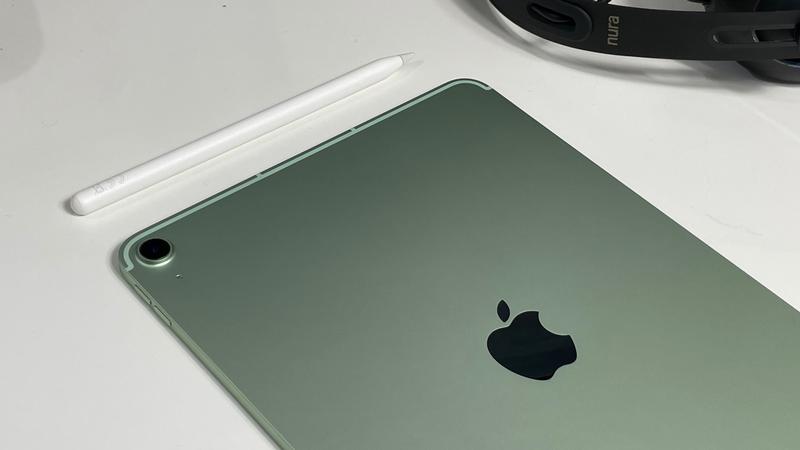

But I’ll conclude on the positive note that the iPad Air, like the iPad Pro models whose design it largely replicates, is a handsome and elegant piece of industrial design: not just attractive from an aesthetic point of view (something which is aided by the smart new colour finishes in blue and green), but slim, light and portable.
Touch ID in an unexpected place
The lack of a Home button normally signifies the use of Face ID. That’s been the case on every all-screen iPhone and iPad so far – until now. The iPad Air (2020), counterintuitively, has Touch ID.
The fingerprint sensor is concealed in the power button on the top edge. Which rather flew under the radar when Apple announced the new iPad, but is really a startling decision from a normally design-conservative company. It has never done this before on any device, and rolls it out on a product for the mid-market – so this isn’t a budget compromise, and it isn’t a premium feature. It just sits in the middle, illogically.
Anyone buying an iPad Pro (or an iPhone 12, for that matter) is left with the sense that Apple could have allowed their device to offer both Face ID and Touch ID, but chose not to. Hopefully the next iPad Pro and the next iPhone will give us the choice of two login systems.
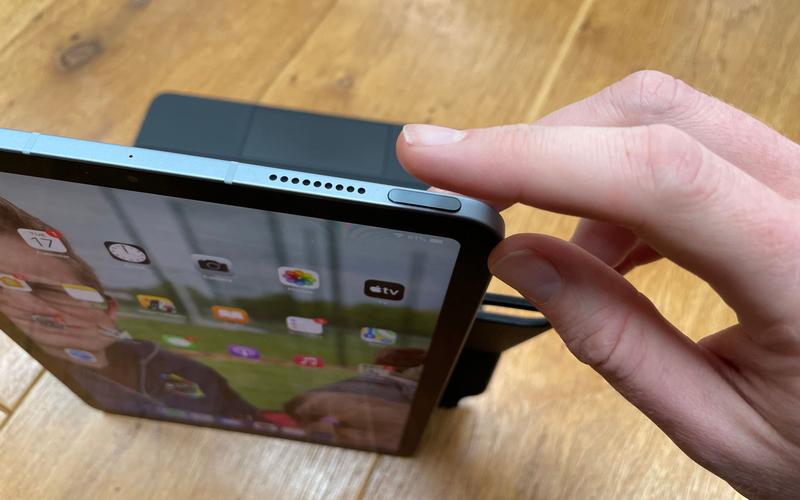

But aside from these existential questions, the Touch ID on the Air is excellent. It’s fast and more reliable than you’d imagine from looking at it. The sensor has a far narrower space to work in, and looks like it would be able to scan only a thin sliver of fingerprint each time – but it hasn’t failed once in multiple weeks of use.
The only thing I’d say against the Air’s Touch ID is that it’s confusingly located, at least at first. When required to log in, your thumb will instinctively head for the place where the Home button isn’t, and it will take a little mental reprogramming before you get used to the sensor’s new position.
You’ll also need to think carefully about which finger/thumb will be the best choice for the various positions you’ll use the Air, and very likely save more than one.
Accessories fit for a pro
I’ve said that in many respects the Air is closer to a Pro than to a standard iPad. And here’s one important way that’s true: the new Air supports both the Apple Pencil 2 and the Magic Keyboard.
These are expensive but high-quality accessories, propelling the Air into the realms of creativity tool and laptop replacement respectively. Support for these previously Pro-only items is not a small thing.
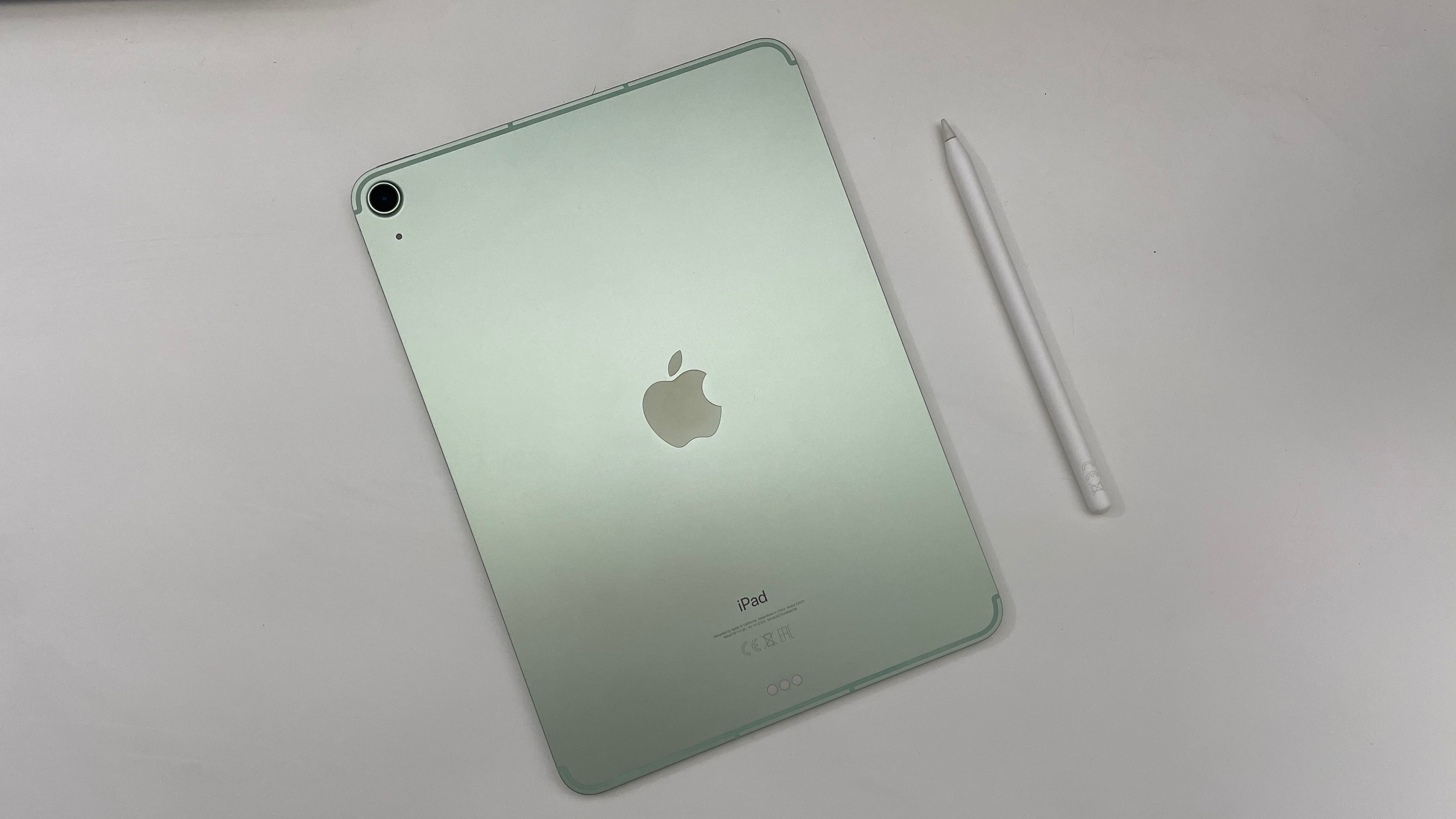

The Apple Pencil 2 (which costs £119/$129) is a far better option than the first-gen model because it attaches magnetically and charges wirelessly. You’re much less likely to find it out of power when you need it, or not to be able to find it at all.
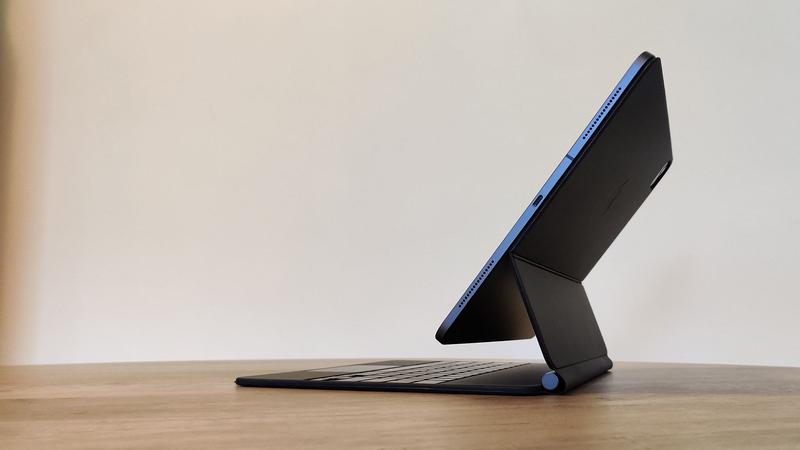

The Magic Keyboard, meanwhile, will set you back £299 for the British version or $299 for the US version. But its robust cantilever design and, crucially, trackpad make it a massive upgrade on the Smart Keyboard Folio. You can work, type and multitask far more easily than on most iPad keyboards.
The Air’s accessory support, along with its USB-C port and ability to quickly transfer large batches of high-res photographs, makes it a realistic option for those who work in the creative and design industries. It makes it a serviceable Pro device, in other words.
Screen: Will you settle for 60Hz?
At 10.9in, the Air’s screen is spacious and perfect for games and films. It’s a small step up from the 10.5in display on last year’s Air, and a more significant step up from the iPad’s 10.2in.
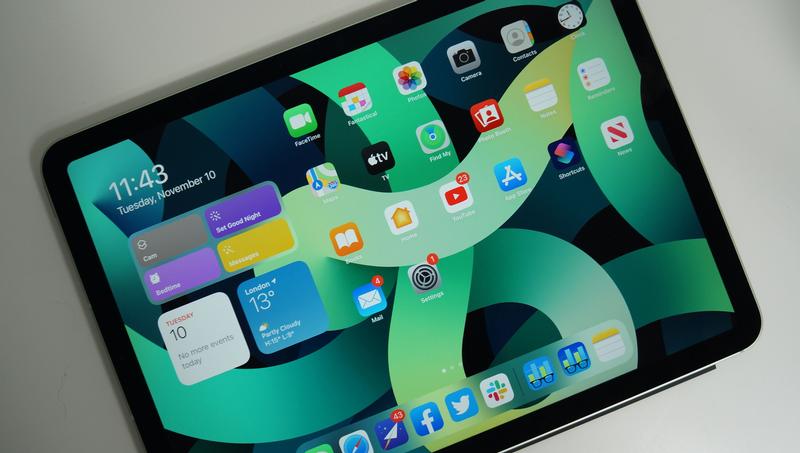

The Air does not offer ProMotion, one of its few concessions to Not Being A Pro Device. Its screen refresh rate is capped at 60Hz, so you won’t get the smoother animation and superior touch responsiveness of the Pro’s 120Hz.
I’m not one of those Apple diehards who claimed, as soon as it was confirmed that the iPhone 12 Pro wasn’t getting ProMotion, that 120Hz was a mirage with no detectable benefits (and who will presumably reverse their opinion when the iPhone 13 does get it). If 120Hz is on the table, you take it. But the differences are not huge – they are far less noticeable, in my opinion, than the difference between a laminated and an unlaminated screen, which hasn’t stopped everyone from buying Apple’s budget iPads.
In any case the screen is otherwise well specced. It offers the same P3 wide colour gamut as the iPad Pro 11in, and virtually the same resolution: 2360×1640 at 264ppi (pixels per inch). Fans of Apple’s smaller devices may baulk at that 264ppi sharpness rating, given that the latest-generation iPhones all offer more than 450ppi, but Apple’s argument that you hold a tablet further from your eye than you would a phone is not totally bogus. And I’ve not noticed any pixellation or fuzziness when using the Air.


The Air’s screen is laminated, unsurprisingly, which means you don’t get the same slightly plasticky ‘give’ when you press down on the basic iPad, and it has the True Tone tech that (optionally) adjusts the screen output to account for ambient lighting conditions.
Ultimately of course the specs are less important than the subjective experience (as Apple always insists on pointing out), and these were consistently good. The Air’s screen is vividly colourful, bright and sharp.
Cameras: The benefits of Smart HDR
With the usual caveat that mid-size iPads are not well suited to photographic work on purely ergonomic grounds, it’s worth spending a little time exploring the Air’s camera setup. Perhaps you won’t be lugging it with you round the tourist spots of Paris, but the front camera in particular will be crucial for the quality of your video calls.


Before we get to that, however, let’s look at the rear – where one obvious difference between this device and its Pro sibling is the lack of a double lens. You just get a single wide-angle lens, although at 12Mp it’s nothing to be sniffed at.
(You might think that having a single lens means you don’t get Portrait Mode – and you don’t. But that’s not why. The iPad Pro offers Portrait Mode on the front, because that’s where the TrueDepth Face ID sensor is.)
The iPad Air gets access to one of Apple’s recent buzzword features: Smart HDR. You may have heard recently about the iPhone 12’s inclusion of Smart HDR 3, an exceptionally sophisticated edition of this feature; here we’re just talking about plain old Smart HDR. But it’s still worth having.
Smart HDR uses multiple exposures and image processing muscle to select the best settings for each part of a photo, enabling you to get satisfying shots in challenging conditions. Such as shaded subjects against strong back lighting:


The iPad 10.2in (which doesn’t get Smart HDR) has made a decent go of it, but its efforts to find a happy medium between the darkness in the vegetation and the brightness of the sun has left the bush murky and grey-brown. The Air has done a better job of capturing proper deep shadows without overexposing the sunlight.
Here’s another comparison using the rear cameras in challenging lighting, and interestingly enough I subjectively prefer the iPad’s shot despite its failings.
Note how the iPad, in trying to capture detail on the subject’s face, has overexposed the sky in a way that is inaccurate (if artistically pleasing). The Air has rendered the sky far more faithfully.
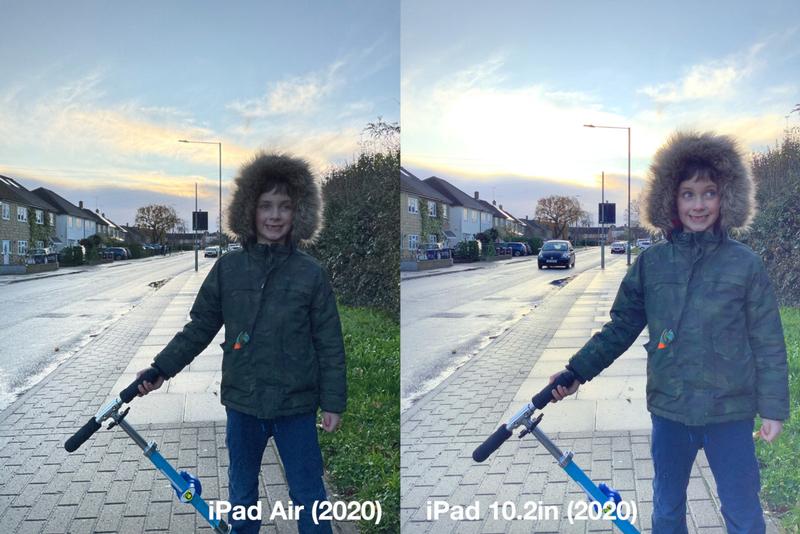

On the front, the Air features a very solid 7MP selfie camera equipped, again, with Smart HDR. That’s the same spec as the iPad Pro.
I took a few of the same selfies with the Air and the iPad 10.2in and, to be frank, there’s no comparison at all. The Air is obviously far more detailed (the 10.2in has a mere 1.2MP front camera) but its image-processing is also visibly more sophisticated.
You will note that this Smart HDR feature isn’t quite on a par with the Smart HDR 3 you get from the 12-series iPhones: that fierce backlighting has caused some problems. But the 10.2in has pretty much given up on tackling the lighting in a realistic way; the sky is almost entirely white.
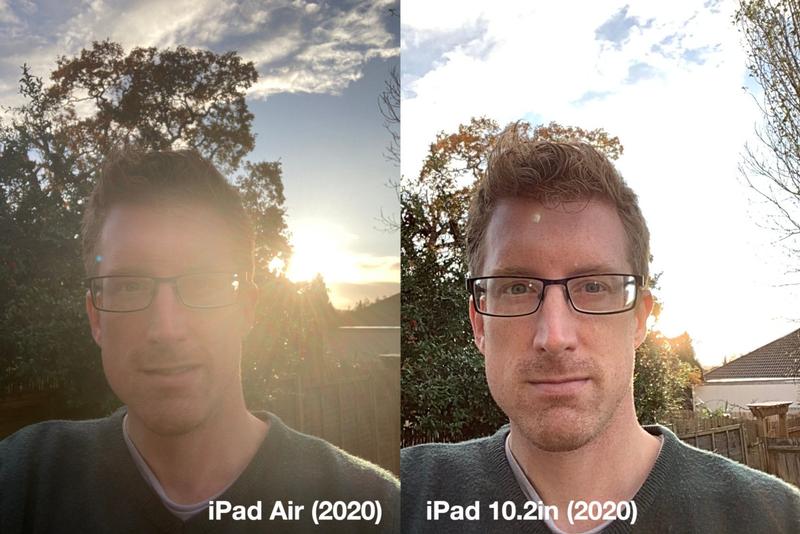

Speed tests/performance
The Air comes with the A14 Bionic chip. That’s quite simply the best, latest and fastest mobile processor that Apple offers, and gives it a huge advantage over tablets equipped with the two-generations-older A12, such as this year’s 10.2in iPad.
Comparing it with the 2020 iPad Pro models is more problematic; they too have a chip from the 12-series, but it’s the A12Z, a greatly souped-up version. I’d suspect that the A14 and A12Z are comparable in power, and the Pro’s extra RAM (6GB, compared to 4GB in the Air) gave it the edge in the multi-core component of the Geekbench 5 benchmarks. But the Air is a lot closer to the Pro than to the vanilla iPad.
The A14’s graphics performance, as we saw when benchmarking the iPhone 12 and iPhone 12 Pro, is less clear-cut in the gains it offers over previous generation. In fact the iPad Air (2019) scored higher in several of the easier GFXBench tests we ran; only in the most difficult did the Air 2020 pull ahead.
Thanks to Lewis Painter on Tech Advisor for the benchmark figures.
It’s important to note that benchmarking gives an idea of a device’s theoretical speed, and the Air clearly has plenty of muscle under the bonnet. But at this point in time, that muscle is overkill.
My real-world impression of the Air is that it’s smooth and slick, admirably fast at accomplishing every task I throw at it and capable of running anything on the App Store with ease. But the same is true of the iPad 10.2in, and it’s only in the years to come, when the apps become more demanding, that the Air’s extra power will come into its own. Think of it as a future-proofing decision.
Battery life
Apple estimates the Air’s battery life at 10 hours of surfing the web on Wi-Fi or 9 hours over a mobile connection, which is the same as last year’s Air, and for that matter the iPad 8 and iPad Pro 11in (2020). The company’s claims give the impression that its mid-size tablets all have the same battery performance.
The truth is messier. The Air 2020 lasted 9 hours 7 minutes in the battery segment of the Geekbench 4 benchmark, which is down about a quarter of an hour on the 9 hours 24 minutes managed by the Air 2019. The iPad 8, meanwhile, was streets ahead with 10 hours 34 minutes.
It’s important to note that Geekbench’s battery test is very demanding and unlikely to reflect your real-life experience: it’s handy for comparing one product to another but not for getting an estimate of how long it will last under everyday conditions.
Indeed my non-benchmark battery experiences were much better. On the first day of testing I unplugged the (fully charged) Air at 7.30am, and when it returned to the charger at 11pm after 15 hours and 30 minutes of gaming, streaming, photography and benchmarking (and a few breaks, as you’d expect in any day of device use), it still had 29% power.
That’s deeply unscientific, but strongly suggests that you should be able to get a day of use out of it without having to worry about power, which I tend to think is the main thing when it comes to battery performance. Anything beyond that is a bonus.
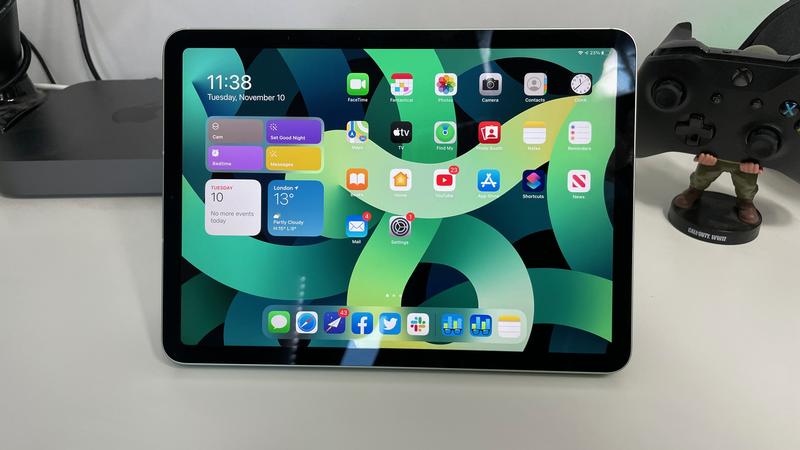

Price & availability
The iPad Air is available now, having hit the shops on 23 October. It starts at £579/$599, which is a step up from the 2019 Air, although I hope I’ve managed to show that Apple has worked hard to justify that.
Here’s the full price list:
- iPad Air 2020 (64GB, Wi-Fi): £579/$599
- iPad Air 2020 (256GB, Wi-Fi): £729/$749
- iPad Air 2020 (64GB, cellular): £709/$729
- iPad Air 2020 (256GB, cellular): £859/$879
You can buy the new Air direct from Apple, but you may be able to find a slightly better deal from a different retailer. Browse our guide to the best iPad Air (2020) deals for our advice on where to buy.
Verdict
The new iPad Air has many qualities, but this could be a double-edged sword for Apple. It’s hard to make much of a case now for the iPad Pro, except in a limited set of niche circumstances, and we’d recommend that most people in the market for a luxury tablet save their money and get this instead.
Because in most respects you’re buying an iPad Pro with a different badge. The design is Pro; the accessory support is Pro; the processing power is Pro-comparable. You even get Wi-Fi 6 and Bluetooth 5.0 (like the Pro) rather than 802.11ac and Bluetooth 4.2 (like the iPad 10.2in).
Battery performance was a slight disappointment in our formal tests (and you’ll get more from the iPad 10.2in) but seemed fine in everyday use. And while there are some losses from the Pro line, such as LiDAR, ProMotion and the ultra-wide camera lens, none of these are essentials.
Overall, then, it’s another victory for the inbetweeners. The iPad and iPad mini are all about the compromises; the iPad Pro is excessive indulgence at an eye-watering price. The iPad Air is just right.


Comments are closed, but trackbacks and pingbacks are open.